This was published 4 months ago
Defending our democracy: How a cranky uncle, Swedish inspo and ‘pre-bunking’ help out
Australia has imported a lot from the UK and the US but our home-grown election system is the envy of the Western world. Will it be enough to inoculate us from AI, fake news and other threats to our way of life?
By Nick Bryant
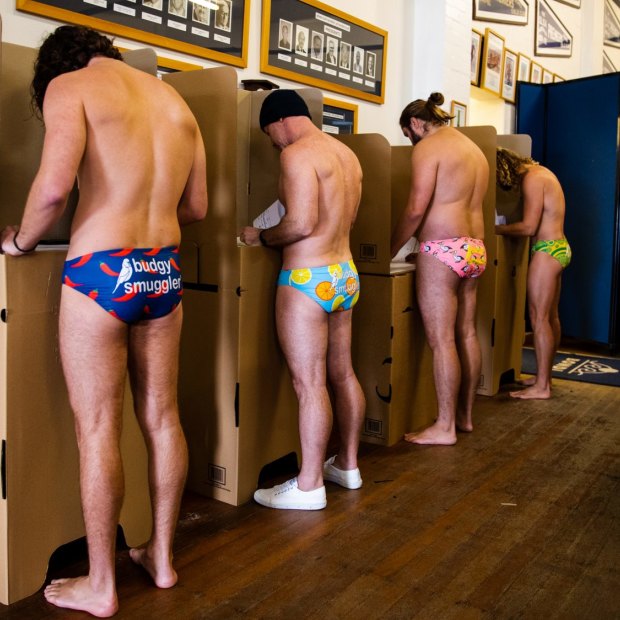
Polling booths at Sydney’s Bondi Beach. “Voting for us is a family occasion, a duty fulfilled, as often as not, on the way to the beach … an obligation, but a light one, a duty casually undertaken,” said writer David Malouf.Credit: Edwina Pickles
The letters arrive at the rate of a dozen a week, addressed to the headquarters of the Australian Electoral Commission (AEC) in Canberra but omitting the official title of the intended recipient, the Australian Electoral Commissioner, Tom Rogers. “When they write to me, they’ll write something like, ‘To the man Tom Rogers doing business as the fake election commissioner’ or ‘Tom of the family Rogers, the living man’,” he says. “They’re always signed with red thumbprints and use archaic language directly out of the US.”
Most are penned – and thumbed – by “SovCits”, as they are sometimes called. Activists aligned with the sovereign citizen movement, a loose group of extreme libertarians who disavow the very concept of the Australian state and who distance themselves from societal institutions. Many refuse to pay taxes or obtain driving licences. The idea of compulsory voting is repellent to them.
“Some are quite mad,” says Rogers. “If we’ve tried to enrol them, quite often they include an invoice for $20,000 for opening the letter from the fake government. It’s completely bonkers.”
Over the 11 years he’s been in charge of overseeing Australia’s elections, Rogers has witnessed a worrying uptick in what he calls “tinfoil hat-wearing” conspiratorialism. “On one level you think it’s only a dozen letters a week, frankly who cares?” he says. “But it’s a bit of a worry that I’m getting that much stuff.”
The world over, democracy is under attack. On January 6, 2021, a sitting American president, who hopes to become the next US president, incited an insurrection aimed at violently overturning the result of a clear-cut presidential election. In Brazil on January 8, 2023, supporters of the far-right former president Jair Bolsonaro carried out a copycat attack in the country’s capital, Brasília, after this “Trump of the Tropics” had also been defeated at the polls. The war in Ukraine is an emblematic struggle between freedom and autocracy. The new cold war pitting the US against China is framed in the same epochal terms. Foreign interference, from bad actors like Russia and China, is where threats to democracy become threats to national security. The world’s richest man, Elon Musk, has become a super-spewer of misinformation through his social media platform X (formerly Twitter), a billionaire who has not only disrupted the economy but been accused of destabilising democracy. The rise of generative artificial intelligence will propagate the mind poison.
The body politic here is hardly immune. Adopting a Fortress Australia mentality, moreover, offers little protection from the contagion. Just consider what unfolded during the COVID-19 pandemic. In Melbourne, anti-lockdown protests paraded a gallows through the streets, seemingly mimicking the January 6 insurrectionists. Some pissed on the Shrine of Remembrance, the city’s holiest shrine. Right-wing politics in Australia has also become more Trumpian. Scott Morrison’s secretive multi-ministerial power grab flouted the Westminster tradition of open government. After meeting Donald Trump at Trump Tower in May, he posted on social media that the former president had been subject to a “pile on”, seemingly dismissing the rap sheet against him, including criminal charges relating to the storming of the US Capitol, the attempt to overturn the election.
Ahead of the Voice referendum, the present Liberal leader questioned the integrity of the poll. Peter Dutton complained the vote was being “rigged” because the AEC ruled that a tick would likely count as a “yes” but a cross would not be counted as a “no”. Yet the decision adhered both to precedent and the strict letter of electoral law.
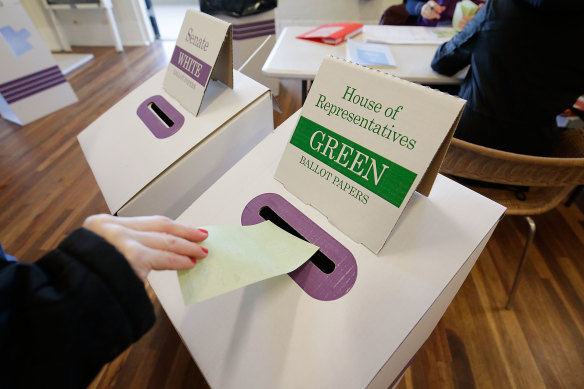
Some conspiracy theorists claimed voting machines were heading for Australia. “You will know that we don’t use any voting machines,” says Australian Electoral Commissioner Tom Rogers. “Never have, never will.” Credit: Getty Images
So at a time when the electoral process is coming under assault on so many fronts, both foreign and domestic, maybe we should be grateful that the ramparts of Australian democracy are manned by a former soldier. Rogers, who grew up on Sydney’s lower north shore, is a graduate of the Royal Military College, Duntroon, and served for 20 years as an officer in the Australian Army. For a time he commanded a UN peacekeeping mission in the Israeli-occupied Golan Heights. Both a strategist, peering at the horizon for long-term threats, and a tactician, responding to day-to-day attacks, Rogers draws inspiration from Australia’s most revered military commander, General John Monash. He tells the story of how, during the Great Depression, a group of disgruntled veterans urged Monash to lead a military coup. “He shot them down straight away,” says Rogers. “He said the future of Australia relies on the ballot box and an educated electorate. I’ve always thought of that, and the two components of that. Not just the vote, but providing citizens with the information they need to vote.”
Combating misinformation and disinformation now consumes much of the Commission’s bandwidth. Ahead of the 2022 federal election, the AEC had to rebut claims that Dominion Voting Systems voting machines would be used to rig the vote. “THE ELECTION STEAL – FIX IS IN,” read a post on Facebook in October 2021, from an account called Seaman John, which got dozens of shares and more than 100 reactions. “AEC to accommodate the utterly corrupt and discredited Dominion Voting Systems – in our next National Election.” It was a local iteration of the Trump conspiracy theory that had been libellously amplified by Rupert Murdoch’s Fox News, which had to pay the Colorado-based company a staggering $US787 million to settle the defamation lawsuit before it went to trial. Yet as Rogers wearily points out: “If you have ever been into an Australian polling booth, you will know that we don’t use any voting machines. Never have, never will. It would be unlawful and illegal.”
Another canard put out by conspiracy-mongers was that the AEC was using outsourced vote-counting software vulnerable to manipulation. Yet every vote is counted by AEC staff at designated AEC venues. Also, there were allegations of voter fraud, after rumours spread that ballot papers had been found near rubbish bins in Port Macquarie. The concocted image, sent to a radio station in Sydney, featured some bona fide AEC ballot papers, which might have been discarded by people who chose not to vote. Others, however, were clearly fake – photocopied on the wrong shade of green paper.
Of all the conspiracy theories, perhaps Rogers’ favourite was the furphy that voters should not use pencils because the AEC would erase their votes. It came on social media with the hashtag #usepen. “I had some gigantic rubber that I was going round after hours erasing 17 million votes,” laughs Rogers. “These are nutty mad conspiracy theories that people pick up overseas and smear across what you are doing.”
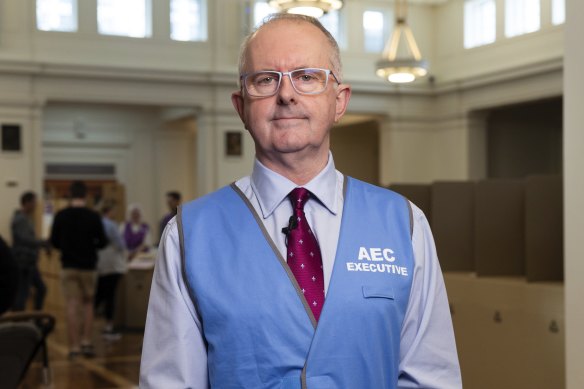
Australian Electoral Commissioner Tom Rogers says some of the letters he receives are “quite mad”.Credit: Alex Ellinghausen
It was around 2013 that Rogers first noticed an escalation in conspiratorialism, which he ascribes to the rise of social media platforms such as Twitter, as X was then known. In 2016, the year of Donald Trump’s shock victory, his concerns grew about the threat from misinformation. Not only was it a question of safeguarding Australia against foreign interference from countries such as China, Iran and even India, but foreign infection from its closest ally, the United States. Protecting the reputation of the AEC became paramount. “What they were seeing overseas was not a failure of electoral administration, it was a failure of reputation. People were deliberately sowing doubt about the validity of electoral results. I’ve got this very strong view that elections are part of national security. Trusting election results is what democratic legitimacy rests upon, so we really went to town.”
Going to town meant establishing the electoral equivalent of a special forces detachment, the Defending Democracy Unit, which was tasked with protecting the AEC’s reputation. Around the world, the AEC is seen as the gold standard in electoral administration, and within Australia it is widely regarded as unimpeachable. Nine out of 10 citizens say they trust how it carries out its work.
At the heart of its reputation management strategy is pre-bunking, as opposed to debunking – countering conspiracy theories before they take flight. The AEC set up a disinformation register, rebutting every fallacious claim that appeared on its radar. It raised its game on social media, that cesspit of disinformation. In 2019, it also set up its own YouTube channel, AEC TV. “It sounds very grand,” says Tom Rogers. “It’s effectively a series of videos filmed in a cupboard with a backdrop. Where we see one of these conspiracy theories online, we will immediately cut one of these videos with one of our experts talking about the actual facts, bang it online straight away and promote it on social. You’ve got to do it quickly. That’s the thing.”
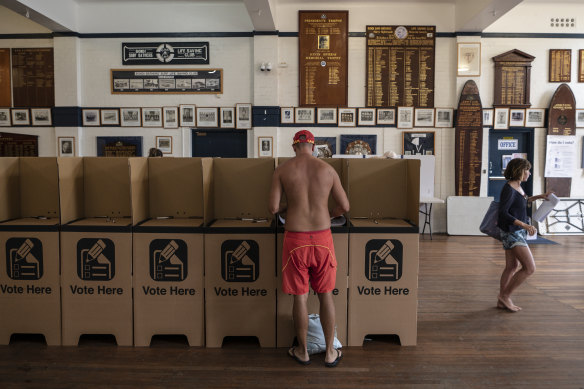
Australia’s way of voting – including mandatory participation – has been praised worldwide.Credit: Flavio Brancaleone
By responding rapidly – counter-attacking, in effect – during the Voice referendum campaign, Rogers was able to quickly refute Dutton’s dangerous comments about vote-rigging. In robust terms, the AEC “completely and utterly” rejected the claim it was acting unfairly, and complained the criticism was “based on emotion rather than the reality of the law”. When I raise Dutton’s comments, Rogers treads gingerly. “I think we’re all responsible for our own statements” is all he will now say.
Yet another countermeasure is the Stop and Consider campaign, introduced ahead of the 2019 federal election, which Rogers says was “shamelessly stolen” from Sweden. “They ran a campaign, ‘If it makes you angry, it is probably fake.’ I really liked that as a tag line, and we did some testing and it didn’t quite fly. So we came up with Stop and Consider.” This public education campaign, promoted on all the AEC’s social media platforms, urges voters to be wary of what they are seeing, reading and hearing. Is it from a reliable source? When was it published? Could it be a scam?
“It’s about getting citizens to consider how they consume information, especially at election time,” says Rogers. “We need to raise the level of digital competence among our citizens to give them the skills they need to work through this. Voters need to understand what is going on in the information ecosystem. We’d be foolish to think in Australia we are immune to these global trends that we have seen in other countries. That’s being turbocharged by the rise of artificial intelligence.”
‘We don’t have huge computers here in the basement where we are able to detect AI.’
The AEC’s Tom Rogers
The rise of AI unquestionably elevates the threat level. A recent report from NewsGuard, a US-based organisation which counters misinformation, found that between May and December 2023, online sites misleadingly hosting mostly AI-generated articles increased from 49 to more than 600. Deepfakes – AI-generated video, images and audio purporting to be real – have already been deployed in the US presidential election. Ahead of the New Hampshire primary in January, voters received phone calls fabricating the voice of President Biden. Fake Joe told them to stay at home rather than vote.
“I think we’re operating at the cutting edge of where our legislation is,” says Rogers, “but I’ve also gone public and said that new developments, such as AI, are complex, and that the Election Act is not set up to deal with that. And technically, internally, we don’t have huge computers here in the basement where we are able to detect AI.” It speaks of the asymmetrical nature of the battle. AEC TV up against AI feels like a David versus Goliath mismatch.
In his scorching 1964 polemic, The Lucky Country, Donald Horne not only complained that Australian politicians were second-rate but that the country’s democratic system was second-hand. “Australia is a lucky country run mainly by second-rate people who share its luck,” is the quote that has echoed down the decades. But it was the beginning of his largely neglected next line that got to the nub of Horne’s thesis: “It lives on other people’s ideas.” Horne bemoaned how Australia was lazily imitative, inheriting and mimicking Britain’s system of governance. As he later explained: “I had in my mind the idea of Australia as a derived society.”
Canberra appeared to prove his critique. Though the nomenclature of the House of Representatives and Senate was imported from Washington, much of the furniture looked like it had been shipped in from Britain. The green-and-red leather benches in Parliament House were modelled on those of the Palace of Westminster. As in Britain, Hansard provided a verbatim record of parliamentary proceedings. Old Parliament House could boast a near-replica of Augustus Pugin’s Speaker’s Chair in the Commons, replete with arm rests incorporating timber from Horatio Nelson’s HMS Victory and a royal coat of arms hewn out of oak from Westminster Hall. To this day, a golden mace, gifted by King George VI, is carried in procession ahead of every sitting day by the Serjeant-at-Arms, who used to don on ceremonial occasions a pair of white gloves, a shirt with a butterfly collar, silver-buckled shoes, stockings and knee-breeches. The full Bridgerton.
For all the ceremonial and procedural similarities, however, Horne’s thesis was too self-belittling. Rather than being imitators, Australians have been the inventors of an emphatically homegrown version of democracy. In 1902, with the passage of the Commonwealth Franchise Act, Australia became the first country where women could stand for parliament. Secret voting, through ballot papers and closeted voting booths, was taken up in America in the late 19th century, where it was called “the Australian ballot”. Though it initially copied the first-past-the-post system used in UK parliamentary elections, in 1918 preferential voting was adopted for the House of Representatives. On October 10, 1924, compulsory voting was signed into law. As the historian Judith Brett has written in From Secret Ballot to Democracy Sausage: How Australia Got Compulsory Voting: “In the second half of the 19th and early 20th centuries, Australia led the world in electoral reform.”

An election-day tradition. “Australia has succeeded in creating a culture of celebration around elections as full-community affairs,” writes one international observer.
Weekend polling also sets it apart from the US and UK. From the sausage sizzles to voters turning up in budgie smugglers and bikinis, the electoral experience is quintessentially Aussie. The writer David Malouf, during his 1998 Boyer Lectures, neatly distilled the essence of Saturday elections. “Voting for us is a family occasion,” he observed, “a duty fulfilled, as often as not, on the way to the beach, so that children early get a sense of it as an obligation, but a light one, a duty casually undertaken.”
Small wonder that Australia’s way of doing things has won international acclaim. “Australia has succeeded in creating a culture of celebration around elections as full-community affairs,” wrote the influential Washington Post columnist E. J. Dionne jnr and Miles Rapoport, a Harvard academic, in their 2022 book, 100% Democracy. As well as emulating the spirit of Australian democracy, they hoped that America would ape its model of compulsory participation. “The United States adopted the secret ballot after Australia tried it first,” they wrote. “We should do the same with universal voting.”
Another American admirer is the Nobel Prize-winning economist Joseph Stiglitz. “There are many institutional aspects of your model which I think other countries should emulate, among them mandatory voting,” he told me during a recent visit to Sydney. “We spend so much money getting out the vote, that sort of spending gives power to those who contribute,” creating a system of “one dollar per vote” as much as “one person one vote”. Preferential voting he also finds attractive. “If the United States had had that, Trump would not even have been on the ballot. And our system gives undue influence to the extremes.” Compulsory voting is a safeguard against polarisation. Elections become less of a base-mobilising exercise and more an appeal to the middle, with all the moderation that implies.
“We’ve been world leaders with the secret ballot compulsory enrolment and compulsory voting,” says Tom Rogers, who is also rightly proud of the statutory independence of the AEC. America, where states set their own electoral rules, has no equivalent body. But each wacky letter that arrives in his in-tray, and each new conspiracy theory that percolates online, reminds Rogers that he cannot let down his guard. According to the Washington-based watchdog, Freedom House, Australia has slipped down the global democratic rankings. In the body’s 2024 Freedom in the World report, Australia ranked 17th on democratic health. Between 2017 and 2019, it had ranked sixth. Some of the slippage is explained by Australia’s tough pandemic lockdowns, which were seen to have infringed on personal liberties. But, at a bare minimum, Australia should strive to remain a top-10 democracy. Ideally, it should become the paragon nation. The democracy sausage needs to remain as succulent and nourishing as possible.
“The challenges facing democracy are of an unprecedented scale, speed and complexity.” In her first interview since becoming head of the Albanese government’s Strengthening Democracy Taskforce, Dr Jeni Whalan makes no bones about the enormity and immediacy of the threat: “We’ve had this period where there’s been a privilege of complacency, where we’ve taken our democracy for granted. That time has passed.”
As the inaugural report from the taskforce pointed out when published in July, anti-democratic sentiment has risen because of the overlapping effects of misinformation, political polarisation, citizen discontent with the trustworthiness of governments and heightened geopolitical tensions. “The challenge is all of the challenges combined,” says Whalan, a Rhodes scholar with a doctorate from Oxford, who would likely have made it on the Australian sailing team at the 2004 Athens Olympics had not injury forced her early retirement from the sport. “We have spoken of a constellation of challenges. And there is no one challenge that’s bigger or a greater priority than the others. It’s the way that they interact, and present new difficulties.”
Australia’s long tradition of democratic innovation could end up being its superpower.
Civic education is a key weapon in the armoury, even if it sounds like bringing a pillow to a knife fight. The Museum of Australian Democracy, housed at Old Parliament House, is a vital bastion. More than 350,000 visitors pass through its doors annually and via digital outreach its educational programs attract an even larger audience online. “They don’t just reach kids of school age,” she says, “but all generations. It is a really crucial component.”
Disinformation experts set great store in what are called inoculation games. The Australian-made Cranky Uncle app developed by John Cook, a University of Melbourne scientist who is also a talented cartoonist, will never emulate the global impact of Bluey but it is seen nonetheless as a pacesetter. Centred on a generic “cranky uncle”, a know-it-all family member who claims to be better informed than the world’s leading scientists, it has helped counter climate-change denialism and vaccine misinformation. Now available in 13 languages, it has been downloaded by tens of thousands of users globally. “In this dangerous information environment, we need to build new tools to build resilience in our communities,” says Whalan. “We need our research community, our scientists, at the forefront to design some of those solutions and interventions.”

The Cranky Uncle app aims to counter dangerous disinformation.
The country’s long tradition of democratic innovation could end up being its superpower. “The strength of Australian democracy didn’t happen by luck,” she says. “It happened by very careful design. From the secret ballot to the enfranchisement of women, from correcting some of the mistakes of our democracy, such as the shameful disenfranchisement of First Nations people, to the design of integrity reforms in the 1970s and ’80s, which is globally renowned among policy wonks. These didn’t happen by accident. They happened by hard graft … Every generation has found a way of doing it. So it’s our time now to rise to that challenge.”
Whalan sees other home-field advantages. Here, there has not been the same “democratic backsliding” evident in other advanced nations, such as America. There is not the same societal atomisation and collapse of communities – the “bowling alone” syndrome identified at the turn of the century by the Harvard academic Robert D. Putnam. Rather, the clubability of Australia, and the strength of civil society, is a valuable resource, even if in recent years there have been signs of fragmentation and fraying. Says Whalan: “Throughout history it’s been organisations like the Country Women’s Association, the RSL, the community choirs and so on. These go to our democratic way of life, not just the formal institutions and processes and legislation and laws. It’s the things in our day-to-day lives, and our culture, in our shared identity. I’ve got a new appreciation of how important that is.”
But how can that contend with modern-day threats posed by artificial intelligence? “It’s the way that AI connects to the challenge coming from social media and digital platforms. It connects to foreign interference. It connects to declining public trust in institutions. It’s the connections between these challenges that makes it alarming, but which also requires a more joined-up, cross-sector approach in the solutions space.”
To keep pace, the Albanese government has promised to develop “Democracy 2.0”, an ambition outlined in a speech by the then home affairs minister, Clare O’Neil, at the Museum of Australian Democracy on the day after Donald Trump survived an assassination attempt in Pennsylvania. This modernisation program includes new legislative powers to hold digital platforms to account and updated regulatory settings to govern AI, striking a balance between its potential for good and propensity for harm. A new technology foreign interference taskforce, known as Techfit, has already been established to combat bad international actors. The National Anti-Corruption Commission was created in 2022 to deter and detect public officials acting unlawfully.
During the September sitting of parliament, the government will introduce its long-awaited electoral reform bill. Its proposals will include donation and expenditure caps on political donations, to protect the system from what the special minister Don Farrell has called “the growing threat of big money in politics.” At the last federal election, Clive Palmer spent $123 million in support of his United Australia Party – although it only ended up with one Senate seat in Victoria. The delayed reform package is also expected to include a “truth in advertising” measure to crack down on misinformation in political ads.
O’Neil claimed Australia could show the rest of the world how to “survive and thrive”. She even echoed the messianism of Labor prime minister Ben Chifley, asserting: “This is Australia’s light-on-the-hill moment.” Her speech, however, was also a reality check. It cited worrisome survey data from the Australian Public Service Commission showing that only half of Australians believe democracy is on the right track.
“Nigh on a decade,” says Jeni Whalan, “the research has been pointing us to a decline in trust in institutions of all kinds, a sense that young people didn’t care about their democracy as much as older generations, a sense of disenfranchisement and entrenched inequality.” Still, she ardently believes that in future-proofing its democratic system, Australia can call on old-fashioned virtues: the country’s pioneering and problem-solving tradition. “Many of the reforms have a wonderfully Australian pragmatism to them. They’re creations that underpin the lofty ideals of democracy but with this very Australian pragmatism and practicality.” But the dizzying speed of technological change, she concedes, is daunting: “The things that will be in place by 2040 are the sort of things we haven’t even thought of yet, that we cannot even begin to imagine.”
What makes this year of democracy so momentous is not just that so many elections are taking place – in more than 60 countries, half the world’s population is going to the polls – but that democracy itself is on the ballot. That’s certainly true in the United States. In India’s election earlier this year, the largest on the planet, the country’s secular democratic tradition was also under threat, which partly explained why its Hindu nationalist prime minister, Narendra Modi, failed to win an outright majority.
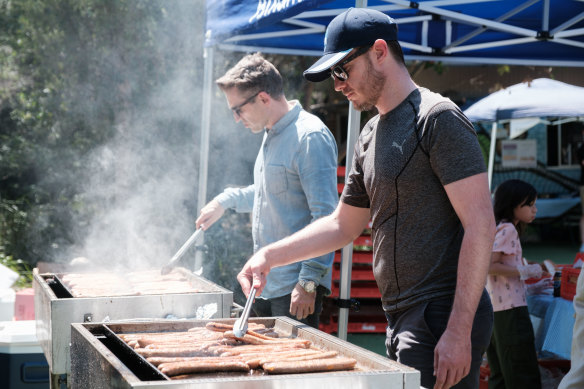
Democracy sausages on Voice referendum day.Credit: Oscar Colman
In contrast to other nations, Australia looks in pretty good shape. But the trend lines are worrying. The Albanese government’s grandest initiative in the democracy space ended in crushing defeat. In the 2023 referendum, the Indigenous Voice to Parliament did not even come close to getting the two majorities in favour to alter the constitution. From Peter Dutton’s attack on the integrity of the AEC to the slew of misinformation about the Voice, including that it could pave the way for land confiscation, the referendum was a poor advertisement for Australian democracy.
With the federal election looming, the democracy agenda, which can often feel abstract to voters, will become a lesser priority. In the recent cabinet reshuffle, Clare O’Neil, who describes herself as a “long-term democracy nerd”, was replaced by Tony Burke, who has now taken over the super-portfolio of home affairs and immigration. Given the degree of difficulty that comes with the immigration brief, safeguarding democracy is unlikely to be uppermost in his mind. Besides, at a time when tensions in the Middle East have raised community tensions here, promoting social cohesion has become more of a priority than democratic resilience, even though they are flip-sides of the same coin. In July, the Labor MP Peter Khalil was appointed the country’s first special social cohesion envoy.
Even commonsense proposals aimed at strengthening democracy come with risks. Take the plan to enact new truth-in-political-advertising laws. It could end up being counterproductive if the AEC is mandated to act as the referee. “The moment we start making pronouncements about what candidates are saying,” warns Tom Rogers, “that will really impact on us.”
At the end of this year, Rogers will also hand on the baton. This sentinel of democracy will end his watch. Already he is reflecting on the changes he has seen since taking over the AEC, at a time when it was reeling from the bungled 2013 Western Australia Senate election, when 1375 votes went astray. “If you had told me back then that we would have a defending democracy unit, the electoral integrity task force and the stop and think campaign, I would have laughed. It was so far away from our experience back then, when elections were just about the sausage sizzle with no thought of misinformation … But it’s a new era.”
Not everyone in Australian politics fully realises that, says Rogers, who recalls a conversation with a parliamentarian from a few years back. “Jeez, you’re lucky mate,” said the pollie. “It’s a church hall and a piece of paper. How hard can that be?”
“That’s the image,” says this old soldier, “and in some ways, that’s not a bad thing. But what’s missing is how democracy is really under threat globally. We’re managing that process in Australia in a really successful way, which is something which I think all Australians should be proud of. But, man, it’s complex.”
To read more from Good Weekend magazine, visit our page at The Sydney Morning Herald, The Age and Brisbane Times.